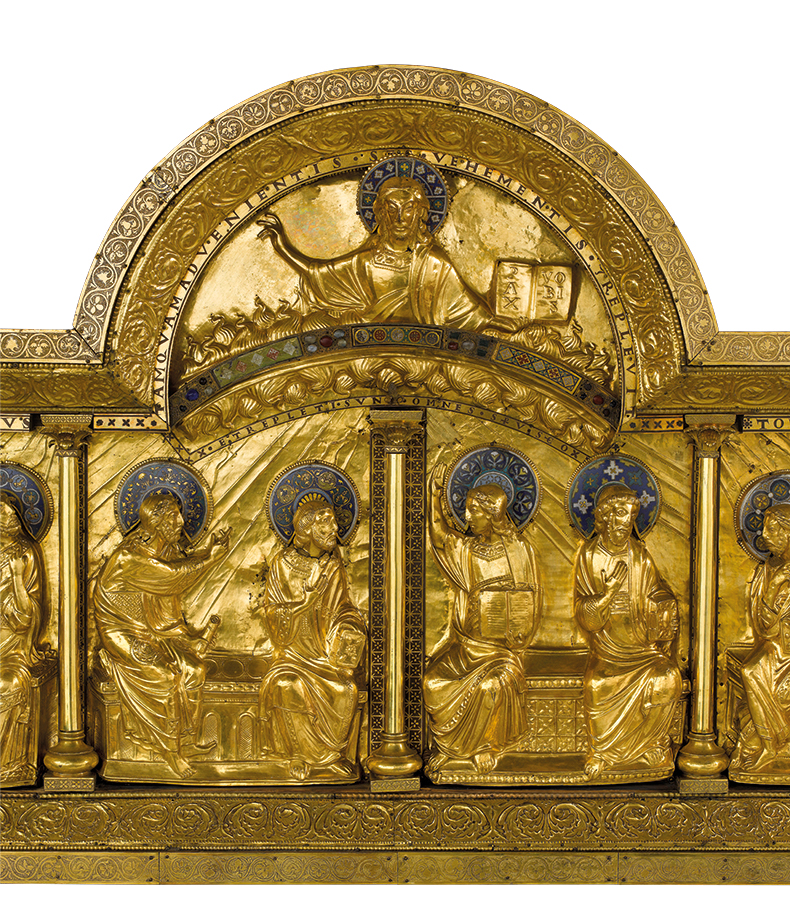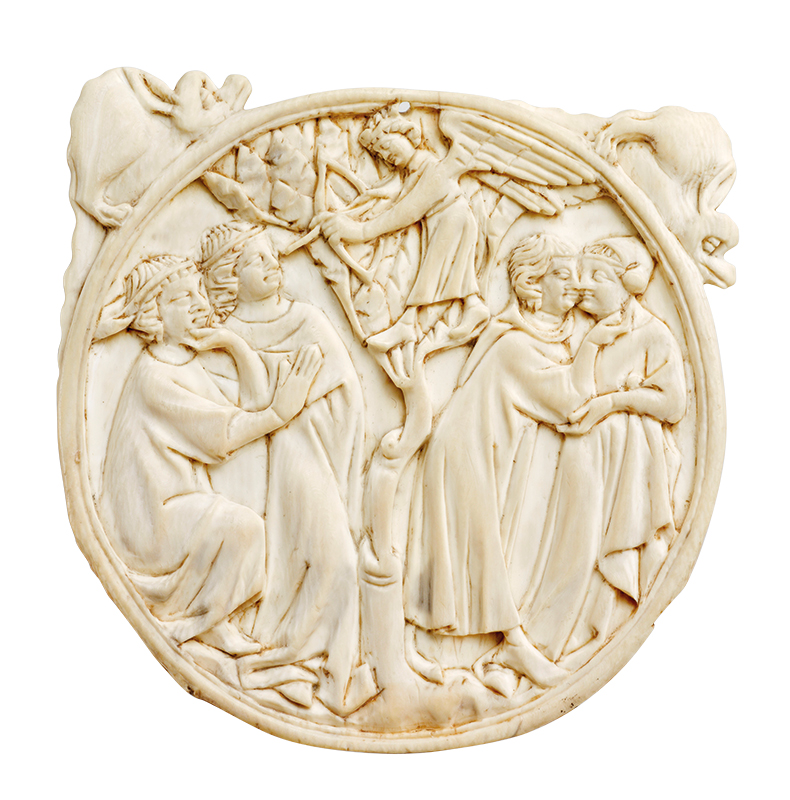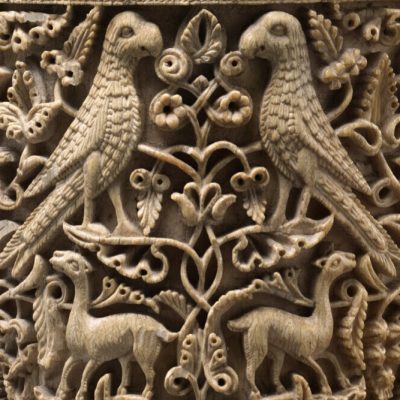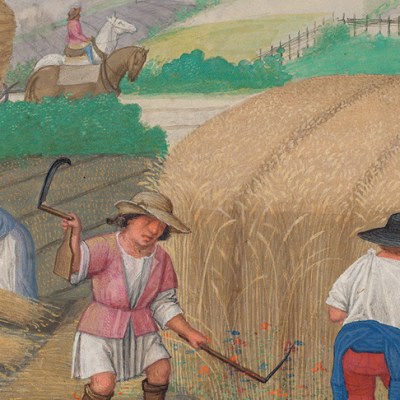From the April 2022 issue of Apollo. Preview and subscribe here.
Walking into the Muséee de Cluny in Paris at the beginning of March as it prepares to reopen after an extensive refurbishment, I think of the boisterous 15th-century mystic and serial pilgrim, Margery Kempe, who wept on seeing the Virgin’s headscarf in the basilica of Saint Francis in Assisi. Margery was famous for her tendency to roar with devotion; I feel a Margery-esque urge to let out a small, museum-visitor-appropriate roar. Just as medieval pilgrims travelled great distances to see particular relics, feeling the sacral power vested in physical objects, I too feel the thrill of being within touching distance of so many strange and beautiful artefacts from the Middle Ages for the first time since the start of the pandemic.
The museum – most famous for its late medieval Lady and the Unicorn tapestries – is itself an architectural tapestry, weaving together structures from different centuries. In the 13th century, an unnamed abbot of Cluny decided to build himself a pied-à-terre in the French capital. He chose the site of a ruined Roman thermal bath and set about incorporating what remained of the spectacular complex – the largest in Roman Gaul – into his scheme. The ruins are still visible today, jutting up from below street level, as a reminder of Paris’s ancient history. Some 200 years after the palatial pied-à-terre was built, the then-abbot – Jacques d’Amboise – substantially remodelled the site, creating a masterpiece in the Flamboyant gothic style.
Photo: © M. Denancé/musée de Cluny – musée national du Moyen-Âge

After the medieval period, the building had a number of owners, including an astronomer, who made use of its tower and a physician who used the cool, stone-walled chapel on the first floor as a dissection room. In 1832, the building was bought by the collector Alexandre Du Sommerard (1779–1842), who made it into a private museum to house his large and eclectic collection of medieval and Renaissance objects. After Du Sommerard’s death, the French state acquired this private museum and made it into a national one.
Needless to say, a building begun in the 13th century, on the site of one built in the first and altered in the 15th (and then again in 19th) is unlikely to remain practical as a site for a museum in the 21st century. Since 2015, the Musée de Cluny has been engaged in an ambitious project to bring the building in line with modern requirements – providing disabled access throughout – and in the process redisplaying its collection. The result is a triumph, revealing the richness and diversity of the museum’s architecture and its collection.
A new entrance brings you into an airy hall lit by a giant window overlooking the Roman ruins – the first and second centuries here interposing on the 21st. This new extension was designed by Bernard Desmoulin. Its exterior is made from panels of cast iron with different textures that shimmer in the light, while the window guards use a pattern derived from the staircase up to the first-floor chapel. The structure was designed to cause minimal disruption to the Roman foundations of the building and is thereby held up by three micro-pillars.
Before it closed, the museum’s collection was organised according to typology (i.e. sculpture together, tapestries together). Some of this remains, as in a room of Limoges enamel, but now the visitor moves through the ages as they move through the museum. After the new entrance, the first room contains artefacts from the Roman and early medieval period; some 20 rooms later you arrive at the early 16th century and the Lady and the Unicorn tapestries.
Golden rose (second quarter of the 14th century), Minucchio Da Siena. © RMN-Grand Palais (musée de Cluny – musée national du Moyen-Âge/Jean-Gilles Berizzi

As is the case with many museums, what began as one man’s idiosyncratic collecting habit became, somewhat ironically, the basis of a national monument, preserved as a key part of France’s national heritage. (The Musée de Cluny is unusual in being the only national museum devoted to the Middle Ages.) The nucleus of the collection is Du Sommerard’s, but the wonder of the museum is how varied it is. Fittingly, for a building in the gothic style, there are plenty of gothic artefacts, but there are also works from the Roman and Romanesque period. Secular objects are to be found alongside expressions of ecclesiastical pomp; high-status artefacts appear alongside pieces that tell us about the fabric of everyday life in the medieval period. One of the museum’s most impressive objects is a golden rose given to the Count of Neuchâtel by Pope John XXII in 1330. As befits a heavenly rose, it is thornless. At the centre of its delicate petals is a large sapphire, from its stem sprout gently curling leaves. Gold has never looked so ephemeral, as though the petals could wither with the change of season at any moment. It is a masterpiece of metal work, a kind of reverse alchemy, whereby gold has been transformed into plant. Looking at it, I think of Abbot Suger (1081–1151), an early patron of gothic art, who was responsible for a redesign of the French royal abbey of Saint Denis, north of Paris. He left us a treatise on his work (De Administratione), in which he describes contemplating a golden cross that he had commissioned for the abbey, saying that the ‘loveliness of the many-coloured gems has called me away from external cares’ and he had been transported from ‘the slime of the earth’ to a region between heaven and earth.
Stavelot Altarpiece (third quarter of the 12th century), France. © RMN-Grand Palais (musée de Cluny – musée national du Moyen-Âge/Jean-Gilles Berizzi

Suger would no doubt have approved of the Stavelot Altarpiece and felt it transported him from the ‘slime of the earth’. It was made for the Abbey of Stavelot near Liège at around the time that he was making modifications to Saint Denis. Across a two-metre-long panel it depicts the Holy Spirit descending on the Apostles. It is made in repoussé – a technique which involves hammering gold. In a domed section at the centre, God appears with an open book. The surface of the gold sheet below has been etched so that rays of light emanate from Him. Below, the Apostles are seated in pairs, each holding a different pose; their haloes are made of enamel. The sheer amount of gold in front of you is dizzying, but the details of the piece are its true splendour: the Apostolic toenails, the edges of their robes, the metal bindings on the manuscripts they hold.
Objects like these speak of the wealth and power of their commissioners, but it’s a joy to see such works alongside door locks and cooking utensils. Some of the most moving artefacts I paused to look at were a collection of tiny dolls’ house utensils made of lead, including spatulas, pitchers, ewers, knives, candlesticks, platters and a little waffle iron, all only centimetres-long. Like many of the lead objects in the museum, they were found in the 19th century in the Seine near the Île de la Cité by Arthur Forgeais. When Margery Kempe wept over a relic of the Virgin’s headscarf in Assisi in 1414, she was moved by an ordinary object rendered extraordinary by its association with the divine. The ordinary artefacts from medieval life in the museum are rendered extraordinary by their age. They are relics in several senses of the word: objects from a former age, but also objects that elicit a kind of secular veneration.
The tiny toy pitchers and candlesticks conjure up moments of lost play and humour, like a backgammon piece made from walrus ivory in the second half of the 12th century. It depicts a knight riding on the back of a cockerel. This kind of surreal imagery was common in gothic artefacts – misericords and manuscript borders from the period show anarchic scenes of knights tilting at snails (as Don Quixote titled at windmills, centuries later), or monkeys riding goats.
Mirror back (14th century). © RMN-Grand Palais (musée de Cluny – musée national du Moyen-Âge/Michel Urtado

The backgammon piece suggests moments of lost humour. The museum’s collection of ivory combs, hair parters (known as gravoirs) and mirror backs from the early 14th century, hint at moments of amorous daydreaming. One mirror back shows the god of love firing arrows at a pair of lovers, another shows the ill-fated lovers Tristan and Iseult. When combs are mentioned in courtly literature, they are often symbols of eroticism. In Chrétien de Troyes’ Lancelot: the Knight of the Cart, while searching for a kidnapped queen, Lancelot finds an ivory comb containing strands of her hair and nearly faints with anguish and longing.
Objects like these connect us in simple, human ways to people in the past. We imagine the roll of a dice, the swoosh of a comb through the hair, hours of childish play with little hands making imaginary food and drinking imaginary drinks. I get a similar sense looking at a 13th-century sculpture of the Virgin and Child, from Lower Saxony, and carved in boxwood. The Virgin is holding the Christ Child tenderly. The baby’s face is turned towards His mother and they are exchanging a kiss. I think again of Margery Kempe, who had a particular devotion to the person of the Christ Child. When she encountered mothers and their children, she was often moved to bouts of noisy devotion thinking of the Virgin’s pain and Christ’s sacrifice. I feel the opposite – seeing these images of the Virgin and Child made me think of my own child at home. Perhaps the sculptor who carved a polychrome sculpture of the Holy Family made in Swabia in the early 16th century saw their own child in the Christ Child. In that sculpture the Virgin, seated on the left, looks up from her book, while a plump and naked Christ Child clambers over Joseph, tugging on his beard. Here Christ has been rendered as a cheeky toddler.
The museum also contains a number of artefacts that make us feel that the Middle Ages was a very different time. In a room of objects from the 15th century is a golden statue of the Virgin and Child seated on a gothic-spired throne. The Virgin wears a jewelled crown, the Christ Child’s right arm is lifted and his fingers make a symbol of blessing. The centre of his stomach is a perfect round disc, inset with mother of pearl. The inscription around the disc reveals that this is a reliquary of Christ’s umbilical cord. In the same room we find a magnificent golden foot. It is a reliquary containing the foot of Saint Adalhard, a cousin of Charlemagne, who was venerated along the Rhine. There was a widespread medieval belief that saints’ bodies did not decay as others did, but to a 21st-century eye, there is something so strange about these relics – the idea of these ghoulish, desiccated bits of flesh, encased in gold. Unlike Abbot Suger, I am not quite transported from the ‘slime of the earth’.
À Mon Seul Désir from the Lady and the Unicorn series (late 15th/early 16th century), France. © RMN-Grand Palais (musée de Cluny – musée national du Moyen-Âge/Michel Urtado

The Lady and the Unicorn tapestry sequence can be found in the penultimate room. In their new display, the tapestries have been hung at an almost imperceptible angle, so that they can be better seen from standing height. The six-piece group depicts a woman in elegant courtly clothing, attended by a unicorn. Five of the six tapestries depict the five senses – hearing, sight, taste, touch and smell. The enigmatic sixth bears the motto, À Mon seul désir (‘to my only desire’). The interpretation of these words has puzzled people for centuries, but its meaning feels somehow irrelevant when you see them up close. Each tapestry is so rich with detail – the carefully individuated plants with their distinct blossoms, parakeets, civet cats, a plump partridge and a monkey with a collar around its neck. These feel like objects to be marvelled at, not understood.
Leaving the museum I am struck, like Margery Kempe and Abbot Suger, by the power of the physical objects I have seen. While they were moved to devotion by what they saw, I am moved as I think of the countless medieval people whose lives these objects evoke. The vast majority of the artists and artisans who made these artefacts are anonymous – all that remains of them is the metal they worked, the threads they wove and the wood they carved. They are our only connection to lives now long receded. And the traces of other lives now lost are also evoked by the museum’s patchwork of buildings. I think of the countless others who lived and worked and bathed on the site in the 2,000 or so years since the thermal baths were made and I wonder what will be there in another 2,000 years.
From the April 2022 issue of Apollo. Preview and subscribe here.


